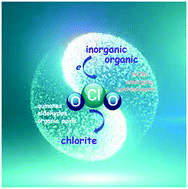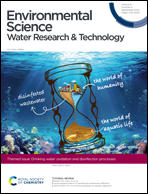The reactions of chlorine dioxide with inorganic and organic compounds in water treatment: kinetics and mechanisms
Abstract
Chlorine dioxide (ClO2), as an alternative to chlorine, has been widely applied in water treatment. In order to better understand the performance of ClO2 in water treatment, the kinetics and mechanisms of ClO2 reactions with inorganic and organic compounds found in waters are critically reviewed. In the case of inorganic compounds, ClO2 reacts with I−, CN−, NO2−, SO32−, Fe(II) and Mn(II) rapidly at apparent second-order reaction rate constants (kapp) of 102–106 M−1 s−1 at pH 7.0 and barely reacts with NH4+ and Br−. In the case of organic compounds, ClO2 selectively reacts with compounds with electron-rich moieties, such as phenols (kapp = 103–109 M−1 s−1), anilines (kapp = 105–108 M−1 s−1), and thiols (kapp > 108 M−1 s−1). ClO2 also shows high reactivity towards aliphatic tertiary amines and heterocyclic nitrogenous compounds (i.e., indoles and piperidines) with kapp of 101–106 M−1 s−1 at pH 7.0, but low reactivity with unsaturated structures (i.e., olefins and aldehydes). The kapp values at pH 7.0 in ClO2 oxidation vary over 14 orders of magnitude. Electron transfer is the dominant pathway for ClO2 reactions. Quantitative structure–activity relationships (QSARs) can be used to predict the species-specific secondary reaction rate constants for ClO2 oxidation of compounds containing phenolic and amine structures. Little modifications are expected on the structure of the parent compounds upon the primary attack of ClO2, but further oxidation generally leads to the formation of quinones, aldehydes and carboxylic acids. Furthermore, the transformation kinetics of inorganic compounds, typical organic compounds and emerging micropollutants are compared and their half-life times under typical water treatment conditions during ClO2 oxidation are calculated.

- This article is part of the themed collection: Drinking water oxidation and disinfection processes


 Please wait while we load your content...
Please wait while we load your content...